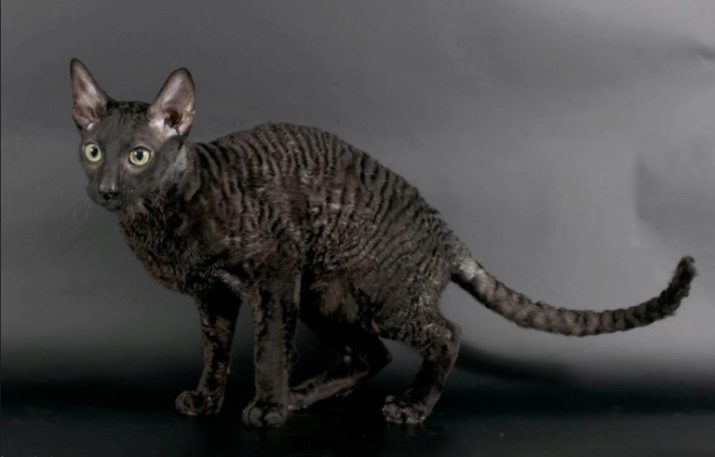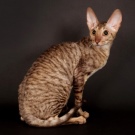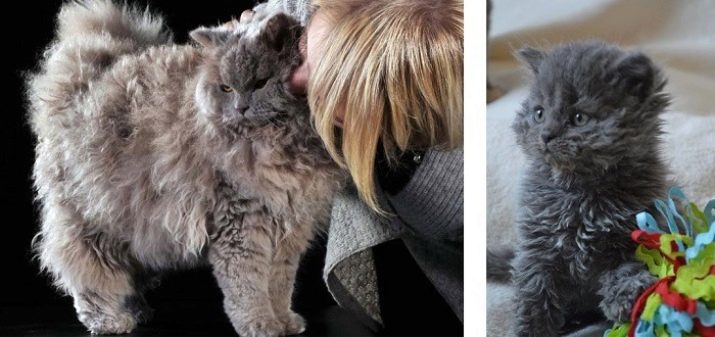Breeds of curly cats and conditions of their keeping

Today there is a huge variety of cat breeds. Some of them are natural, while others have been artificially bred by breeders. That is why such animals are very popular and often become pets - each person can choose a cat for himself, depending on individual preferences and needs.
There are breeds with long and short hair, hairless cats, tricolor and monochromatic. If you are looking for an unusual pet for yourself, then you should pay attention to curly cats. A distinctive feature of these pets is the non-standard wavy coat.

What are the features of curly cats, what breeds exist, in what conditions such a cat should be kept, how to care for its fur - let's talk in more detail.
Peculiarities
All curly cats, regardless of size, color and intensity of curls, are united in one large group called rex. This name indicates the fact that these animals have a special rex gene, due to which their wool is wavy. At its core, such a gene is a kind of mutation (but not artificial, but natural) - it began to manifest itself without any outside interference.
After scientists noticed such a mutation, they began to fix it. As a result of large-scale selection work, curly-haired cats were born with a variety of external characteristics (color, size).


It should be noted that curly cats, in addition to their unusual coat, have other special advantages and characteristics that distinguish them from other breeds.Thus, the hairline of an animal does not emit the unpleasant odor typical for cats. The molt period is also specific for these breeds. It is thanks to these properties that a curly breed kitten can become an excellent friend and pet for you.

I must say that the first breed of cats that contained a rex mutation in their body was officially recognized only in 1967.
Breeds
To date, several possible variations have been recorded in the gene that is responsible for the curliness of the cat's fur. It is depending on this that all curly cats are divided into several breeds. Consider what kind of animals are, and what is the name of each breed.
Cornish Rex
The Cornish Rex breed was the first species of curly cats to be officially recorded. Thanks to historical sources, it can be established for certain that the first registered cat was named Kalibunker, and its owner was Nina Ennismore. It was Nina who gave the name to the unusual mutation of the fur of cats, which we still use today.
Calibunker lived with his mistress in England, in the county of Cornwall. The unusual kitten was born in 1950. After Nina Ennismore, who was familiar with the process of animal breeding (since she was at that time engaged in breeding rabbits), noticed the unusual coat of the kitten, she waited for his puberty, and then crossed the individual with his own mother.

After the story went public, and the photos of the unusual animals were published, enthusiastic scientists took over. It is believed that the first progenitors of the Cornish were crossed with the Siamese breed of short-haired cats.
If we talk about the structure of the wool of such an animal, then it should be noted that the individual hairs of the cover are rather thin. The curls themselves are directed towards the skin (they are also called internal).
Generally speaking, Cornish Rex cats are animals that have long legs and a rather muscular body. Due to these characteristics, the animal is able to move quite elegantly and flexibly. The head of the cat has a wedge-like shape, large eyes and rather large ears are located on it. The tail of the animal is thin and mobile.

Cornish is a shorthaired breed... However, the hairline is dense and thick. The waviness is fairly uniform and occurs throughout the body. There is a wide variety of colors of such a cat - it can be either one-color (for example, white), and three-color (combining black, white and red).

Devon rex
This breed of curly cats was also bred in England. However, despite this similarity with the breed described above, the Devon Rex also has its own distinctive features, in particular, such characteristics include the type of genetic abnormality, coat structure and general appearance. In addition, in scientific circles, it is believed that the Cornish is an American-style breed, and the Devonian is a European variety.

The anatomical structure of the animal is also quite unusual. So, the body itself is powerful and muscular, but the cat moves on rather long legs. Due to this feature, the body of a cat may seem rather awkward and disproportionate. The head is rather large, but the muzzle itself is shortened and flattened with prominent cheekbones (this feature can also be observed in the British breed of cats). The rib cage is rather wide and massive, but the neck is thin. The cat's eyes are slanted.

If we talk about the direct structure of the coat, it is important to note that the integumentary long guard hairs are absent, and the curls themselves do not have an exact direction and can be directed both inward and outward.
German rex
To date, there is no consensus among scientists about how and where this breed was bred.Some believe that German curly cats are the descendants of Prussian animals, while others, on the contrary, completely deny this opinion. Only one thing is known for certain - German Rex received official status in 1982. Moreover, it is important to note that on the territory of our country, as well as in other CIS countries, this breed is not very widespread.
However, this fact is compensated by the great love for German Rex on the part of the inhabitants of Europe.

If we talk about the distinctive characteristics of this breed, then you should first of all refer to the reviews of the owners of such animals. So, they report that the structure of the coat of the Germans is similar to the Cornish. However, in the latter, the coat is sparser, not as dense and elastic. On the other hand, with regard to anatomical features, the German breed is similar to the Devon Rex. Thus, we can conclude that German curly cats are a kind of synthesis of the characteristics of the Devons and Cornish.

Selkirk Rex
Unlike the breed described above, the history of the origin of the Selkirks is known for certain. So, these cats were bred by the efforts of breeders from the United States of America, namely from the state of Montana.
This breed, unlike the ones described above, is younger, since the Selkirk mutation was first discovered only in 1987, and the official registration took place, in turn, only in the early 1990s.
Selkirks differ from their counterparts in many ways. One of the most outstanding is the fact that this breed consists of several subspecies: long-haired and short-haired animals. In addition, the Selkirk Rex is a cat that is rather large in size and weight, possessing a heavy bone.
The musculature on the body of the cat is also pronounced. The head has a round shape, on which there is a rather wide muzzle with a prominent chin. In addition, unlike some other curly breeds, the Selkirk's legs are proportional, and the tail is thick and not very long.

The structure of the cat's coat is rather thick, curls curl in large waves. However, an unknowing person, seeing such an animal, may decide that it has not been combed out for a long time, since the wool is rather randomly twisted.

Laperm
From a linguistic point of view, the history of the origin of the name of the breed is quite interesting. So, the word "laperm" is derived from the English word perm, which translates as "perm". This breed is even newer and younger than the previous one - it received its official recognition in 2002.

A distinctive feature of the laperm is its long coat. The body, like that of other curly cats, is rather muscular, and the legs are long. The muzzle has a rounded shape, the ears are set wide apart, and the eyes are slanted. The coat is tough and may appear a little prickly.

Interesting fact. In order to assess the quality of the wool (for example, this is relevant at various exhibitions), you need to blow the laperm on the wool. From direct exposure to air, curly fur should crumble in different directions.
The 5 breeds of curly cats listed above are officially recognized and registered, however, there are several other species of animals that are not currently recorded in any registers.
- Skokum (or dwarf laperm). The homeland of these animals is the United States of America. The breed was bred thanks to the crossing of Laperm and Munchkin.
- Ural rex. The name speaks for itself - this breed is from Russia. The cats have medium-length coats.
- Danish rex is one of the most unstable breeds, as it is characterized by a high mortality rate and a tendency to baldness.
- Oregon rex from the United States is considered an extinct breed.
- Czech (or Bohemian breed) was created on the basis of the Persian variety.
- Beloyarsky Rex from Russia it is distinguished by a rather coarse, thick and short coat.






However, even this list is not exhaustive, there are many other species: Dakota Rex, Pennsylvania Rex, astrakhan cat and many others.
Conditions of detention
Curly cats do not need any special conditions of keeping in comparison with any other breeds. So, the cat needs to equip a toilet, as well as a place to eat. Toys and scratching posts will come in handy for him.



A curly-haired pet, like any other pet, needs a lot of attention. Therefore, you should not neglect communication with the cat - play outdoor games with him, use toys or just pick it up and stroke it.

Also pay special attention to the diet - it must be balanced. Cats can be fed with dry food or natural food. If you prefer the latter option, make sure that the food for the cat is fresh and tasty - do not feed the animal with leftovers from the master's table. In the event that you decide to feed your pet dry food, then give preference only high-quality formulations from trusted brands.

Periodically, curly cats can be given vitamin complexes to improve their health, as well as various treats for cats, which can be purchased at almost any zoological store.
Don't forget about vaccinations and regular check-ups with your veterinarian. At the first manifestations of the disease, visit veterinary clinics, do not self-medicate, as it can cause negative consequences (up to death).

Hair care
Due to the fact that a distinctive feature of curly cats is their fur, it is precisely to caring for it that you need to devote a fairly large amount of time. So, first of all, it is worth remembering that cats need to be combed out regularly with the help of special brushes and combs. Do not allow tangled clumps to form on animal fur.

In addition, curly cats need to be bathed - this procedure should be carried out with a frequency 2 times a month (that is, every 2 weeks). The temperature of the bathing water should not be lower than 38 degrees Celsius, and during the procedure, it is necessary to ensure that there are no drafts.

Do not shower your cat when bathing.
Use as a detergent only special shampoo for curly cats, under no circumstances use detergents that are intended for humans. At the end of the procedure, dry the cat with a towel, but do not use a hair dryer - the coat should dry naturally.

For more on curly cats, see the video below.
































